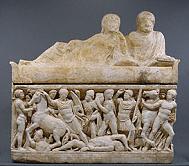• Reproduction of Statuette of a Lyre Player and His Companion by an unknown Greek artist
• Reproduction of Sarcophagus with Scenes from the Life of Achilles by an unknown Roman artist
• Reproduction of Odysseus and the Daughters of Lycomedes by Baldassare Peruzzi
• Background Information and Questions for Teaching about the statuette, sarcophagus, and drawing
• Internet access
• Student Handout: "Homer, Oral Tradition, and the Trojan War"
• Student Handout: "Battle of Achilles and Hector from Homer's Iliad"
• Book: The Children's Homer by Padraic Colum (New York: Aladdin, 2004) (optional)
• DVD player
• DVD excerpt of a modern-day retelling of the battle of Hector and Achilles, such as scenes from Troy (dir. Wolfgang Petersen, 2004; rated R), Helen of Troy (dir. John Kent Harrison, 2003; unrated), or The Odyssey TV miniseries (dir. Andrei Konchalovsky, 1997; unrated) (Note: Please consult your school district's policy on watching excerpts of any films.)
• Drawing pencils and paper
• Art Activity: "Create a Quick Gesture Sketch" (PDF, 254KB, 1 p.)
• Watercolor paper
• Pens
• Small paint brushes and brown ink (you may wish to substitute coffee)
|
 |
 |
 |
Common Core Standards for English Language Arts
Grades 6–8
READING
Key Ideas and Details
1. Read closely to determine what the text says explicitly and to make logical inferences from it; cite specific textual evidence when writing or speaking to support conclusions drawn from the text.
SPEAKING AND LISTENING
Comprehension and Collaboration
1. Prepare for and participate effectively in a range of conversations and collaborations with diverse partners, building on others' ideas and expressing their own clearly and persuasively.
2. Integrate and evaluate information presented in diverse media and formats, including visually, quantitatively, and orally.
Visual Arts Content Standards for California Public Schools
Grade 6
1.0 Artistic Perception
1.2 Discuss works of art as to theme, genre, style, idea, and differences in media.
1.3 Describe how artists can show the same theme by using different media and styles.
2.0 Creative Expression
2.4 Create increasingly complex original works of art reflecting personal choices and increased technical skill.
3.0 Historical and Cultural Context
3.3 Compare, in oral or written form, representative images or designs from at least two selected cultures.
4.0 Aesthetic Valuing
4.1 Construct and describe plausible interpretations of what they perceive in works of art.
Grade 7
3.0 Historical and Cultural Context
3.2 Compare and contrast works of art from various periods, styles, and cultures and explain how those works reflect the society in which they were made.
5.0 Connections, Relationships, Applications
5.2 Use various drawing skills and techniques to depict lifestyles and scenes from selected civilizations.
Grade 8
4.0 Aesthetic Valuing
4.3 Construct an interpretation of a work of art based on the form and content of the work.
English–Language Arts Content Standards for California Public Schools
Grade 6
Reading
3.0 Literary Response and Analysis
3.2 Analyze the effect of the qualities of the character (e.g., courage or cowardice, ambition or laziness) on the plot and the resolution of the conflict.
3.8 Critique the credibility of characterization and the degree to which a plot is contrived or realistic (e.g., compare use of fact and fantasy in historical fiction).
Listening and Speaking
1.0 Listening and Speaking Strategies
1.5 Emphasize salient points to assist the listener in following the main ideas and concepts.
2.0 Speaking Applications (Genres and Their Characteristics)
2.1 Deliver narrative presentations:
a. Establish a context, plot, and point of view.
b. Include sensory details and concrete language to develop the plot and character.
Grade 7
Reading
3.0 Literary Response and Analysis
3.3 Analyze characterization as delineated through a character's thoughts, words, speech patterns, and actions; the narrator's description; and the thoughts, words, and actions of other characters.
3.4 Identify and analyze recurring themes across works (e.g., the value of bravery, loyalty, and friendship; the effects of loneliness).
Grade 8
Reading
3.0 Literary Response and Analysis
3.3 Compare and contrast motivations and reactions of literary characters from different historical eras confronting similar situations or conflicts.
3.7 Analyze a work of literature, showing how it reflects the heritage, traditions, attitudes, and beliefs of its author. (Biographical approach)
Listening and Speaking
2.0 Speaking Applications (Genres and Their Characteristics)
2.1 Deliver narrative presentations (e.g., biographical, autobiographical):
a. Relate a clear, coherent incident, event, or situation by using well-chosen details.
c. Employ narrative and descriptive strategies (e.g., relevant dialogue, specific action, physical description, background description, comparison or contrast of characters).
History–Social Science Content Standards for California Public Schools
Grade 6
6.4 Students analyze the geographic, political, economic, religious, and social structures of the early civilizations of Ancient Greece.
4. Explain the significance of Greek mythology to the everyday life of people in the region and how Greek literature continues to permeate our literature and language today, drawing from Greek mythology and epics, such as Homer's Iliad and Odyssey, and from Aesop's Fables.
6.7 Students analyze the geographic, political, economic, religious, and social structures during the development of Rome.
8. Discuss the legacies of Roman art and architecture, technology and science, literature, language, and law. |
 |

|
 |





